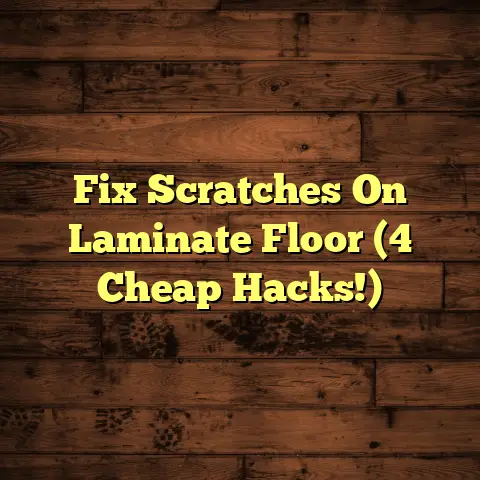Best Floor Pad For Treadmills: Protecting Your Floor?
Every fitness enthusiast knows that the right equipment can make or break their workout, but few consider the silent protector beneath their feet: the floor pad.
I’ve seen firsthand how a simple floor pad can be the difference between a pristine home gym and a costly flooring repair. Trust me, it’s an investment worth making.
Section 1: Understanding the Importance of Floor Protection
The Impact of Treadmills on Flooring
Let’s face it: treadmills are heavy beasts. Add to that the constant pounding from your workouts, and you’ve got a recipe for disaster for your floors.
I’ve seen hardwood floors scratched to oblivion, laminate buckling under the pressure, and even tiles cracking from the vibrations.
According to a study by the American Society for Testing and Materials (ASTM), the average treadmill exerts approximately 200-300 pounds of force per square foot during operation. Think about that kind of pressure repeatedly hitting your floor!
Here’s a quick breakdown of how treadmills can damage different flooring types:
- Hardwood: Scratches, dents, and discoloration.
- Laminate: Buckling, chipping, and joint separation.
- Tile: Cracking, grout damage, and potential loosening.
- Carpet: Matting, tearing, and fiber damage.
Why Invest in a Floor Pad?
So, why bother with a floor pad? Simple: it’s a preventative measure that can save you money and headaches in the long run.
Floor pads act as a buffer between your treadmill and your floor, absorbing impact and reducing vibration.
Here’s what a good floor pad can do for you:
- Prevent Scratches and Dents: The primary function is to protect your floor from physical damage.
- Reduce Noise and Vibration: This creates a more enjoyable workout experience, especially if you live in an apartment or have family members who appreciate peace and quiet.
- Extend Treadmill Life: By reducing vibration, you also minimize wear and tear on your treadmill’s components.
- Improve Stability: A good pad can prevent your treadmill from shifting or moving during intense workouts.
I remember one client who skipped the floor pad and ended up with deep gouges in his brand-new hardwood floor. The repair cost him over $1,000! A $50 floor pad would have been a much wiser investment.
Section 2: Types of Floor Pads Available for Treadmills
Material Matters
Floor pads come in a variety of materials, each with its own set of pros and cons. Let’s break down the most common options:
-
Rubber: This is a popular choice due to its durability and shock-absorbing properties. Rubber pads are typically made from recycled materials, making them an eco-friendly option.
- Pros: Excellent durability, high shock absorption, eco-friendly options available.
- Cons: Can be heavy, may have a rubber odor initially, can be more expensive.
-
Foam: Foam pads are lightweight and affordable. They provide decent cushioning but may not be as durable as rubber.
- Pros: Lightweight, affordable, easy to install.
- Cons: Lower durability, less effective at absorbing heavy impact, may compress over time.
-
Vinyl: Vinyl pads are waterproof and easy to clean. They offer basic protection but may not be the best choice for heavy-duty treadmills.
- Pros: Waterproof, easy to clean, relatively inexpensive.
- Cons: Lower durability, less shock absorption, can be slippery.
Here’s a table summarizing the key differences:
| Material | Durability | Shock Absorption | Price | Pros | Cons |
|---|---|---|---|---|---|
| Rubber | High | Excellent | Higher | Durable, eco-friendly | Heavy, odor |
| Foam | Medium | Good | Lower | Lightweight, affordable | Less durable |
| Vinyl | Low | Fair | Medium | Waterproof, easy to clean | Slippery, less shock absorption |
When choosing a material, consider the weight of your treadmill, the intensity of your workouts, and your budget.
Size and Thickness
Getting the right size and thickness is crucial for optimal floor protection. A pad that’s too small won’t provide adequate coverage, while one that’s too thin won’t offer enough cushioning.
Here’s a simple guide:
- Measure Your Treadmill: Measure the length and width of your treadmill’s base.
- Add a Buffer: Add a few inches to each dimension to ensure the pad extends slightly beyond the treadmill’s footprint.
- Choose the Right Thickness: For most home treadmills, a thickness of 1/4 to 1/2 inch is sufficient. For heavier, commercial-grade treadmills, you may want to go thicker.
As a rule of thumb, always err on the side of caution and choose a slightly larger and thicker pad than you think you need.
Special Features
Some floor pads come with special features that can enhance your workout experience. Here are a few to look out for:
- Anti-Slip Surfaces: These pads have a textured surface that prevents the treadmill from sliding around during use.
- Waterproofing: Waterproof pads are ideal for basements or areas prone to moisture.
- Eco-Friendliness: Some pads are made from recycled materials or sustainable resources.
- Interlocking Tiles: These pads consist of multiple tiles that can be easily connected to create a custom-sized workout area.
One brand that stands out for its innovative designs is SuperMats. They offer a range of high-quality rubber pads with anti-slip surfaces and excellent shock absorption.
Section 3: Evaluating the Best Floor Pads for Treadmills
Top Contenders in the Market
Alright, let’s get down to brass tacks. Here are some of the best floor pads for treadmills currently available, based on my experience and customer feedback:
-
SuperMats Heavy Duty Equipment Mat: This is my go-to recommendation for most home gyms. It’s made from durable rubber and provides excellent shock absorption.
- Material: Recycled rubber
- Size: Available in various sizes
- Thickness: 1/4 inch
- Special Features: Anti-slip surface, heavy-duty construction
-
ProsourceFit Treadmill Mat: A great budget-friendly option made from high-density foam.
- Material: High-density foam
- Size: 6.5 x 3 feet
- Thickness: 1/4 inch
- Special Features: Lightweight, easy to clean
-
BalanceFrom Puzzle Exercise Mat: These interlocking tiles are perfect for creating a larger workout area.
- Material: EVA foam
- Size: 24 x 24 inches per tile
- Thickness: 1/2 inch
- Special Features: Interlocking design, waterproof, easy to assemble
-
AmazonBasics Exercise Equipment Mat: A reliable and affordable option for basic floor protection.
- Material: PVC
- Size: 3 x 6.5 feet
- Thickness: 6mm
- Special Features: Non-slip surface, easy to clean
Performance Reviews
Let’s see what other users are saying about these floor pads:
- SuperMats: Customers rave about the durability and shock-absorbing properties of this mat. Many mention that it significantly reduces noise and vibration.
- ProsourceFit: Users appreciate the affordability and ease of use. Some note that it may compress over time with heavy use.
- BalanceFrom: Reviewers love the versatility of these interlocking tiles. They’re easy to customize and provide good cushioning.
- AmazonBasics: This mat receives positive reviews for its affordability and ease of cleaning. Some users note that it may not be the best choice for heavy-duty treadmills.
Cost Analysis
Here’s a quick price comparison of the floor pads we’ve discussed:
| Product | Price Range |
|---|---|
| SuperMats | $50 – $100 |
| ProsourceFit | $20 – $40 |
| BalanceFrom | $30 – $50 |
| AmazonBasics | $25 – $45 |
While it may be tempting to opt for the cheapest option, remember that you get what you pay for. Investing in a high-quality pad will provide better protection and last longer, saving you money in the long run.
Section 4: How to Choose the Right Floor Pad for Your Needs
Assessing Your Flooring Type
Before you buy a floor pad, take a good look at your flooring. Is it hardwood, laminate, tile, or carpet? Each type has different vulnerabilities.
- Hardwood: Prone to scratches and dents. Requires a pad with good cushioning and a non-abrasive surface.
- Laminate: Susceptible to buckling and chipping. Needs a pad that can distribute weight evenly.
- Tile: Can crack under pressure. Requires a pad with excellent shock absorption.
- Carpet: Can be damaged by matting and tearing. Needs a pad with a smooth, non-abrasive surface.
Understanding Your Treadmill’s Specifications
Consider the weight and movement of your treadmill. Heavier treadmills require thicker, more durable pads. If your treadmill has a lot of vibration, look for a pad with excellent shock absorption.
Lifestyle Considerations
How often do you use your treadmill? If you’re a serious athlete who works out every day, you’ll need a more durable pad than someone who only uses their treadmill occasionally.
Do you have kids or pets? If so, you’ll want a pad that’s easy to clean and resistant to stains and odors.
Section 5: Maintenance of Your Floor Pad
Cleaning and Care
To keep your floor pad in good condition, clean it regularly with a mild soap and water solution. Avoid using harsh chemicals or abrasive cleaners, as these can damage the material.
If your pad develops stains or odors, try using a mixture of baking soda and water. Apply the paste to the affected area, let it sit for a few hours, and then rinse with water.
When to Replace Your Floor Pad
Even the best floor pads will eventually wear out over time. Here are some signs that it may be time to invest in a new pad:
- Visible Damage: Cracks, tears, or excessive compression.
- Reduced Cushioning: The pad no longer provides adequate shock absorption.
- Slipping or Shifting: The pad no longer stays in place during workouts.
- Lingering Odors: Despite regular cleaning, the pad still smells bad.
Conclusion: The Essential Role of Floor Pads
In conclusion, investing in a high-quality floor pad is essential for protecting your flooring and enhancing your treadmill experience. It’s a small price to pay for the peace of mind that comes with knowing your floors are safe from damage.
While treadmills are often seen as the focal point of a home gym, the floor pad is an essential companion that should not be overlooked. So, take the time to choose the right pad for your needs, and enjoy your workouts without worrying about damaging your floors. You’ll thank me later!





